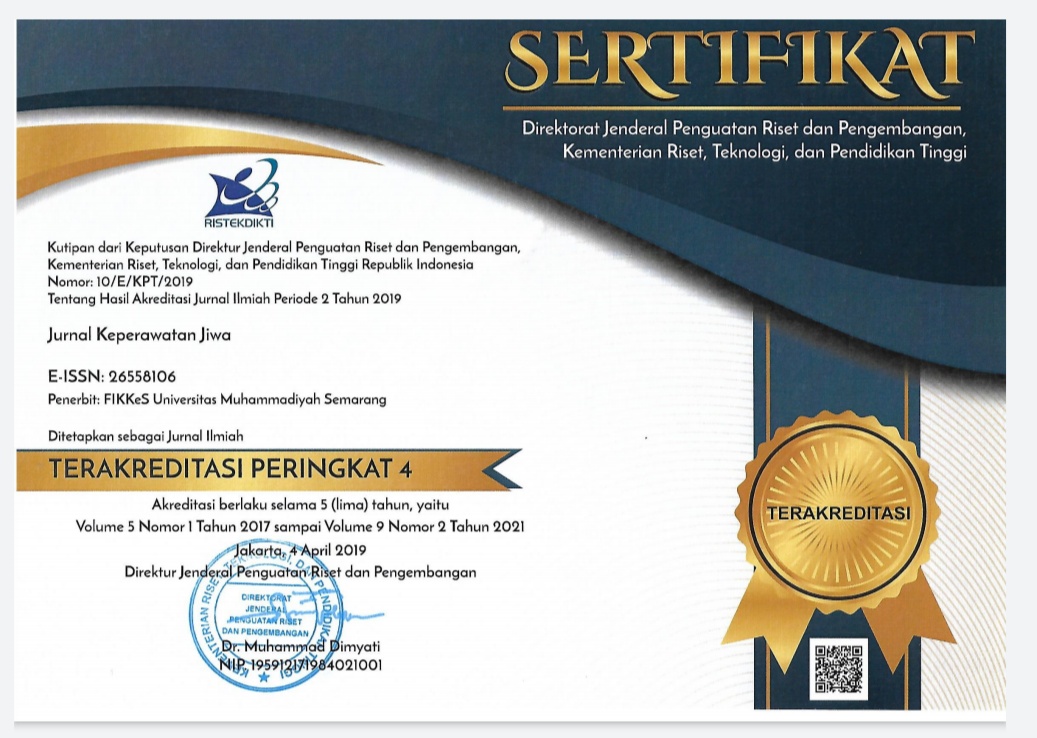Relationship of Family Environmental Conditions with Types of Juvenile Delinquency
(1) STIKes Santo Borromeus
(2) STIKes Santo Borromeus
(3) STIKes Santo Borromeus
(*) Corresponding Author
Abstract
This study is motivated by the existence of family environment conditions that influence juvenile to do delinquency. The purpose of this study is to find out whether there is a relationship between the condition of the family environment with the type of juvenile delinquency. The sample uses a total sampling of 130 respondents in children's penitentiary. The research method used quantitative, correlational descriptive designs, and cross sectional approaches. The research instrument was in the form of a questionnaire with validity ≥ 0.374 and reliability 0.975. The family environment is the first and foremost education for children. The family is an informal educational institution, no less important than formal institutions, so there are differences in the personality of individuals against a background of family differences. The results of univariate analysis found 81 respondents (62.3%) have good family environment conditions. The results of the chi-square test did not correlate family environment conditions with the type of juvenile delinquency (> 0.05).
Keywords
Full Text:
PDFReferences
Anggono, F. R. (2014). Perilaku vandalisme pada remaja di kabupaten Kulon Progo. Skripsi
Asih, M. K., Winarno, R. D., & Hastuti, L. W. (2012). Hubungan Konfirmitas Teman Sebaya dan Keharmonisan Keluarga dengan Kenakalan Remaja pada Anak Didik Lembaga Pemasyarakatan Anak Kutoarjo. Prediksi,1(2),189. (http://journal.unika.ac.id/index.php/pre/article/download/2 7 0/261 Diunduh pada: 14-01- 2020 pada pukul 08:08 WIB).
Ayu F., Hidayati, N. O., & Mardhiyah, A. (2019). Gambaran Resiliensi pada Remaja.Jurnal Keperawatan 'Aisyiyah, 4(1),13-21 (http://journal.stikesaisyiahbandung.ac.id/index.php/jka/article/download/2/2/Diunduh pada: 10-07-2019 pada pukul 15:25 WIB).
Bushman, B. J., Newman, K., Calvert, S. L., Downey, G., Dredze, M., Gottfredson, M., . . . Webster, D. W. (2016). Youth violence: What we know and what we need to know. American Psychologist, 71(1), 17-39. doi:http://dx.doi.org/10.1037/a0039687
Eko. B. (2012). Pengelolaan Kenakalan Siswa di SMA Negeri 1 Ngadirojo (Doctoral dissertation, Universitas Muhammadiyah Surakarta). (http://eprints.ums.ac.id/2435.Diunduh pada: 14-01- 2020 pada pukul 08:07 WIB).
Epstein, M., Hill, K. G., Bailey, J. A., & Hawkins, J. D. (2013). The effect of general and drug-specific family environments on comorbid and drug-specific problem behavior: A longitudinal examination. Developmental Psychology, 49(6), 1151-1164. doi:http://dx.doi.org/10.1037/a0029309
Fairfax-Columbo, J., Fishel, S., & DeMatteo, D.(2019). Distinguishing “incorrigibility” from “transient immaturity”: Risk assessment in the context of sentencing/resentencing evaluations for juvenile homicide offenders. Translational Issues in Psychological Science, 5(2), 132-142. doi:http://dx.doi.org/10.1037/tps0000194
Fellasari, F., & Lestari, Y. I. (2017). Hubungan Antara Pola Asuh Orangtua Dengan Kematangan Emosi Remaja. Jurnal Psikologi, 12(2), 84-90. (http://103.193.19.206/index.php/psikologi/article/viewFile/3234/2034 Diunduh pada: 12-06-2019 pada pukul 08:59 WIB).
Jufri, M. (2016). Analisis Kriminologi terhadap Perilaku Geng Motor sebagai Bentuk Kenakalan Remaja Di Kota Palu. Katalogis, 3(12). (http://jurnal.untad.ac.id/jurnal/index.php/Katalogis/article/download/6483/5170. Diunduh pada: 11-01- 2020 pada pukul 15:43 WIB).
Kartono K. (2014). Gangguan Psikis. Jakarta: Sinar Baru.
Lawson, K. M., Sun, X., & McHale, S. M. (2019). Family-friendly for her, longer hours for him: Actor-partner model linking work-family environment to work-family interference. Journal of Family Psychology, 33(4), 444-452. doi:http://dx.doi.org/10.1037/fam0000506.
Matlasz, T. M., Frick, P. J., Robertson, E. L., Ray, J. V., Thornton, L. C., Wall Myers, T. D., . . . Cauffman, E. (2020). Does self-report of aggression after first arrest predict future offending and do the forms and functions of aggression matter? Psychological Assessment, 32(3), 265-276. doi:http://dx.doi.org/10.1037/pas0000783
Meesuaisint, M., Pathumcharoenwattana, W., & Boonprakob, P. (2018). Characteristics of authentic self-esteem of violent juvenile delinquents in thailand. The Humanistic Psychologist, 46(2), 175-187. doi:http://dx.doi.org/10.1037/hum0000089
Nawafilaty, T. (2016). Persepsi Terhadap Keharmonisan Keluarga, Self Disclosure dan Deliquency Remaja. Persona: Jurnal Psikologi Indonesia, 4(02).(http://jurnal.untagsby.ac.id/index.php/persona/article/download/559/514Diunduh pada: 15-06-2019 pada pukul 16:37 WIB).
Neny. R. R. (2012). Tinjauan Kriminologis Tentang Kejahatan Pencurian Kendaraan Bermotor. Skripsi. (http://103.195.142.17/handle/123456789/3004?show=full Diunduh pada: 10-01-2020 pada pukul 20:02 WIB).
Santrock, J. W. (2011). Perkembangan Anak Edisi 11 Jilid 2. Jakarta: Erlangga.
Sarfika Rika, dkk. (2018). Usulan Penelitian Dosen Pemula Studi Fenomenologi Stigma Remaja Terhadap Gangguan Jiwa Di Kota Padang. skripsi. (http://repo.unand.ac.id/12994/1/RIKA%20SARFIKA- FKEP-RDP.pdf. Diunduh pada: 09-09- 2019 pada pukul 18:20 WIB).
Skeem, J. L., Kennealy, P. J., Tatar,Joseph R.,,II, Hernandez, I. R., & Keith, F. A. (2017). How well do juvenile risk assessments measure factors to target in treatment? examining construct validity. Psychological Assessment, 29(6), 679-691. doi:http://dx.doi.org/10.1037/pas0000409
Sophiarany, N & Helda. (2014). Hubungan faktor individu, keluarga,dan lingkungan dengan penyalahgunaan napza pada remaja yang bersekolah di tiga provinsi di Indonesia tahun 2011. Jurnal
Stuart & Sundeen. (2013). Keperawatan Jiwa Edisi 6. Jakarta: EGC
Syafii, A. (2009). Pengaruh Narkoba terhadap Kenakalan Remaja di Sulawesi Tengah. Media Litbang Sulteng, 2(2). (http://jurnal.untad.ac.id/jurnal/index.php/MLS/article/dow nload/53/46. Diunduh pada: 13-01-2020 pada pukul 06:56 WIB).
Undang-Undang Republik Indonesi. online. (https://peduliwni.kemlu.go.id/app/download/referensi/UU _no_11_th_201 21.pdf.html).
Voisin et al. (2017). Involvement in the Juvenile Justice System for African American Adolescents: Examining Associations with Behavioral Health Problems. (https://www.ncbi.nlm.nih.gov/pmc/articles/PMC5616175/ pdf/nihms852146.pdf Diunduh pada: 10-07-2019 pada pukul 14:51 WIB).
Article Metrics
Abstract view : 594 timesPDF - 79 times
DOI: https://doi.org/10.26714/jkj.8.3.2020.319-328
Refbacks
- There are currently no refbacks.
PPNI Univ. Muhammadiyah Semarang
Jl. Kedungmundu Raya No. 18 Semarang Gedung NRC University of Muhammadiyah Semarang
Phone: 02476740287
Fax: 02476740287
Email: [email protected]
This work is licensed under a Creative Commons Attribution 4.0 International License.


